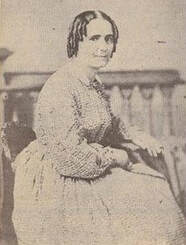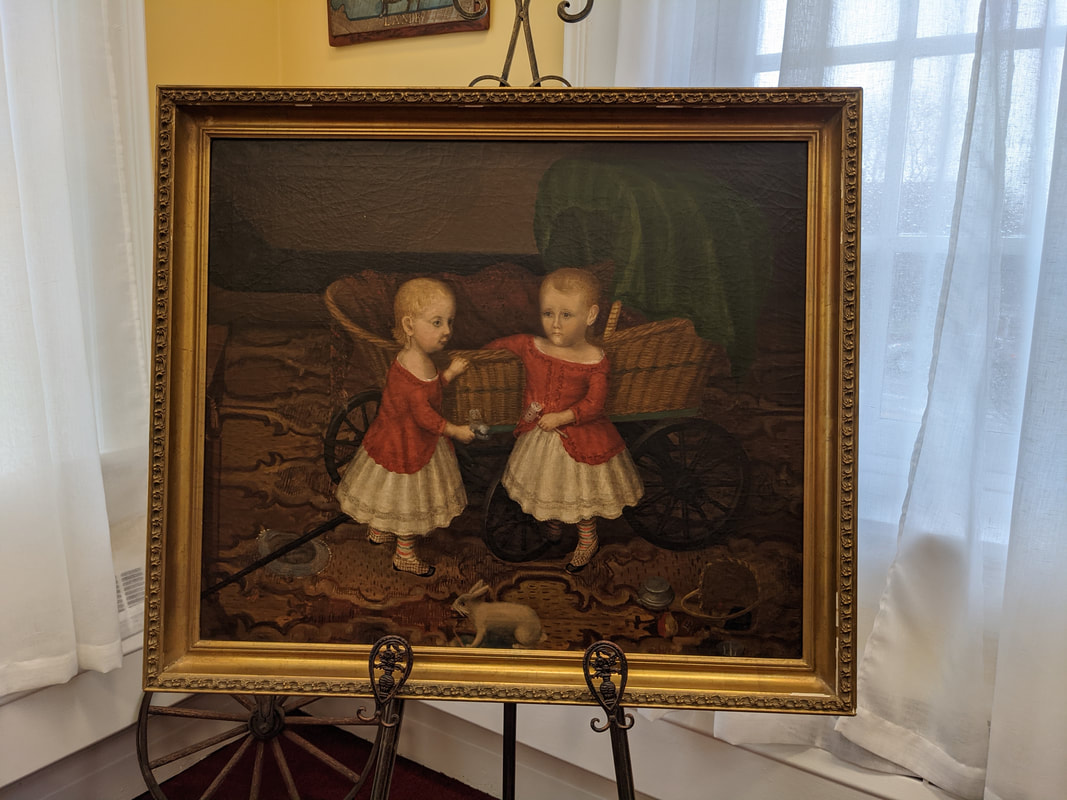 Use Wifi? Thank Hedy Lamar. In 1942, the Golden Age of film actress/Mathematician teamed up with composer George Antheil to develop a radio guidance system for Allied torpedoes using frequency-hopping spread spectrum technology. Though the technology was not employed until the late 50s, it was used during the conflict with Cuba and later would become the Bluetooth and Wifi we use today. The two were inducted into the National Inventors Hall of Fame in 2014. #notjustaprettyface #InternationalWomensMonth
0 Comments
- Sylvia Outland, Art Curator
March 14th marked the return of the portrait, featured on Antiques Roadshow, of John Milton Charters and William Morris Charters (1846 - 1848) twin sons of Dr. William Morris Charters (1806 - 1883) and Cynthia Dutton Seely (1809 - 1860). Both portraits were painted, circa 1849, by Marcus Mote a Quaker artist living and working in Warren County. The Betsy H. Maple Trust, represented by Karri Hamilton daughter of Betsy Maple, (second wife of William Chester “Chet” Maple) personally delivered the painting the family gifted to the Harmon Museum. Both paintings descended in the family of Charters Dyche Maple (1899 - 1958) to his sons William Chester Maple (1935 - 2009) and Dixon Charters Maple (1929 - 2001).  Joyce Lovins Browning is a native of Ohio growing up in the Harrison and Okeana areas. She has been performing Living History for over 19 years. She retired after 20 years as the Naturalist Coordinator from Great Parks of Hamilton County in 2018, and now enjoys working as a part-time Tour Coordinator for Ohio Travel Treasures, sending groups on wonderful bus tour adventures. She'll be portraying Annie Oakley in our April Lunch and Learn. Since childhood, I have always been drawn to antique objects; they bring a relevance and history which contemporary objects do not offer. This experience led to my exploration of historical drawings and etchings from the Victorian period, starting with Edwin Landseer, who was one of the most popular animal illustrators during this time period.
Images of animals and children started to proliferate at the turn of the century as people sent greeting postcards and also read magazines like Harper’s Weekly which contained stories written and illustrated in serial fashion. Printed magazines were available all over the country as reading became an important cultural activity and literacy increased. In addition, life was documented and shared in wonderfully illustrated children’s books. One can imagine domestic scenes by the fireside involving reading and the slow activity of embroidery. Artwork and literature are rife with cultural symbols; they are a tool which teach our youth as well as shape adult behaviors. Morals abound in these tales, both about humans and animals. At this time, animals started to be seen as domestic companions and valued for their loyalty and compassion. Many of these prints show scenes of tenderness and altruism, while others illustrate acts of aggression and barbary. These stories and the prints which accompanied them, had a profound effect upon public perception of the treatment of animals and children leading to new organizations for their protection including the Society for the Care and Protection of Animals (SCPA) and new child labor laws. Using research from this important historical period, I created a series of embroidered drawings on wool. There is a kind of nostalgia in these images, not of a perfect world, but a slower paced life with some sweetness. It is also important to note that the cultural awareness which awakened regarding children and animals unfortunately did not extend to all humanity, especially African Americans and immigrants. The resulting embroideries seek to shine light upon our collective potential for acts of altruism and bravery, amidst the presence of depravity. How can we extend the generosity of animals and children into contemporary society so that all people can find tenderness, sensitivity to others and begin to understand our collective value?  Amanda Stokes (1820-1885) was raised on a farm in Warren County. By the outbreak of the Civil War, in 1861, 41-year-old Amanda, against the advice of friends and relatives, obtained from the Surgeon General a commission as a hospital nurse with orders to report to Federal troops in the South. Amanda worked in dozens of field hospitals near such battles as Stones River, Chattanooga, Chickamauga, Nashville and Atlanta. She fought for items she felt were essential in caring for "her boys." Finding little support from the U.S. government, she took her own money and spent it for the comfort of the soldiers. One day, the ambulance Amanda was riding was crossing the Chattahoochee River. The horses became unruly and overturned the wagon into the river. Amanda escaped through a hole in the top of the ambulance, injuring her head in the process. In the accident she lost not only her personal belongings but also her commission. Attempts to apply to the Surgeon General's office for a duplicate proved fruitless since no copy had been made. After the war, Amanda, with the aid of scores of “her boys,” was appointed Matron of the Ohio Soldiers and Sailors Orphans Home at Xenia, Ohio. A pension of eight dollars a month was eventually granted to her by a special act of Congress. Amanda died on March 28, 1885 in Xenia. She is buried in the Lebanon Cemetery with the simple marker: “Amanda Stokes 1820-1885 Army Nurse.” - John Zimkus In the 1970s and 80s, Lebanon played host to the Cincinnati Symphony for a series of concerts. What started as a concert for the July 4th Mini Festival soon grew into a concert series due to its popularity, More dates were added to include a number of musical guests. At its peak, concerts were held eight months out of the year. One four-part series was held, in the summer months, on the lawn at Berry Middle School and, during the winter months, the auditorium of the Junior High. The auditorium was actually built with hosting the symphony in mind. This all changed with the construction of Riverbend and the concert series ceased to be.
Until now... |
AuthorVarious staff and volunteer writers. Categories
All
Archives
June 2024
|
Email: [email protected]
Wchs Office/Harmon MuseumTues - Sat: 10am - 4pm
Year Round |
1795 BEEDLE cABINPhone for hours
Year Round |


 RSS Feed
RSS Feed





